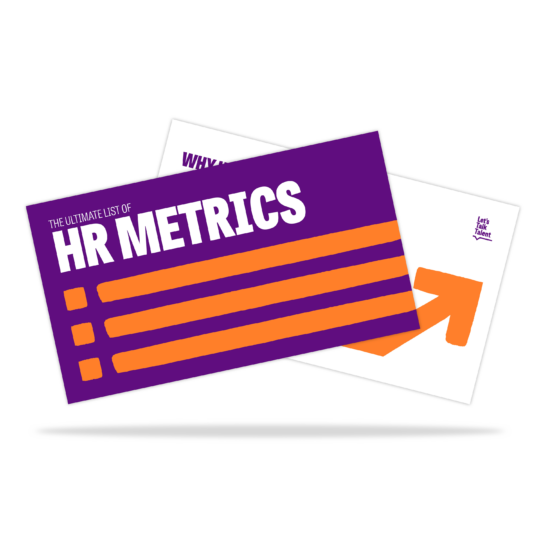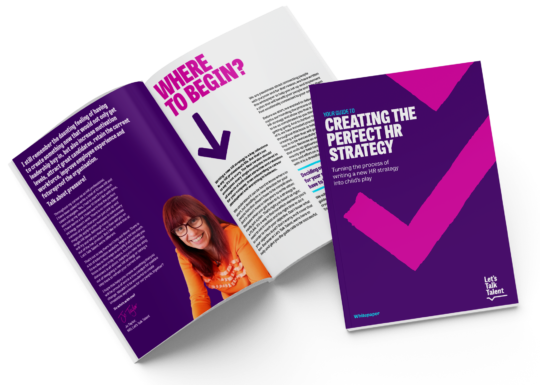Everything you could possibly want to measure about your employee experience to help you get great people and keep great people
We know that as HR professionals, you have a lot on your plate. You have to ensure employees are engaged and feel valued, that managers are equipped with the tools they need to support their team’s career development whilst also achieving team performance goals, and that your efforts and initiatives are closely aligned with business strategy. Talk about a job and a half.
For some, it may be hard to know where to start. Attacking all issues at once, from high talent turnover rates to low employee engagement levels, isn’t an option many organisations can afford to choose. That’s why focusing on your single most important problem is usually the best approach. We like to call it ‘your exam question’.
How HR data can help optimise your employee experience
But how can you determine what this should be? How do you come up with your big exam question?
At Let’s Talk Talent, we like to know what we’re working with. So we usually start with data from audits, surveys, focus groups, interviews and HR automation tools to truly understand employees and their challenges. Setting out initial benchmarks throughout the main touch-points of an employee’s lifecycle can help spot areas for improvements that may warrant your immediate attention. A bit like a geologist studying volcanoes, monitoring their core temperature and seismic movements for signs of activity. But volcanoes are fairly simple to measure. People, on the other hand, are multifaceted. How can HR departments quantify happiness and job satisfaction? Which of the many data sets available should you keep an eye on to maximise performance and contribute to organisational goals?
Don’t worry, we’re here to help.
We have compiled a list of all the metrics you will ever need to review in order to benchmark and improve every single stage of your employee experience within your business. From the moment candidates first hear about you as an employer, until the day they leave.
Important Employee Value Proposition (EVP) metrics: measuring the strength of your brand
Marketing principles, when applied to your brand as an employer, can help generate interest amongst the best candidates available. Using the following set of metrics will allow you to find out if your EVP is strong enough to attract the right fit:
- Number of applicants per opening
- Average number of applicants per vacancy
- Prospects conversion rate
- Average time to hire
- Completion rate for applications
- Recruitment funnel effectiveness (as a ratio of successful applications per funnel stage)
- Applicants demographics
- Job referral percentage (percentage of applicants referred by internal staff)
- Organisation external rating (through platforms such as Glassdoor)
HR metrics to optimise your recruitment efforts
The process of recruiting is a costly one. Reviewing and boosting its effectiveness should be high on your priority list. Try measuring and tracking:
- Satisfaction rates during the recruitment process (also known as candidate experience)
- Cost per hire
- Overall recruitment costs as a ratio of company performance
- Sourcing channel effectiveness
- Sourcing channel cost
- Hiring fill rate
- Applicants per hire
- Offer acceptance per hire
- Internal vs external hiring ratio
- Percentage of open positions (or total number of vacancies)
- Ratio of open positions vs total number of positions within the company
Improving your onboarding programme using data
Considering that the majority of staff turnover happens within the first 45 days of a new employee starting work, it’s worth ensuring that your onboarding programme is up to scratch:
- Turnover rate within the first 90 days
- Turnover rate within the first 180 days
- First-year attrition
- Voluntary turnover rate within the first 90 days
- Voluntary turnover rate within the first 180 days
- New hire failure rate
- New hire employee satisfaction
- Onboarding training completion rate
- Time to productivity
- Quality of hire (using performance ratings)
- Hiring manager satisfaction
- New candidate job satisfaction
Key talent management metrics to help you retain staff: the six types of data you need to measure
Once your talent pool has been with you for a while, your focus should naturally shift from attracting great people to keeping great people. But this is easier said than done as employees will be at various stages of their careers, and therefore have different sets of requirements.
Employee engagement metrics
The below will help you spot (and react to) drops in staff motivation levels, allowing you to step up your talent retention efforts:
- Employee happiness / satisfaction
- Engagement rate
- Employee turnover rate
- Employee retention rate
- Employee recognition (frequency, type)
- Employees most likely to leave your organisation (flight risks)
- Employee benefits participation rate
Tech company Microsoft, for example, uses HR data to ‘(…) profile key leavers and develop initiatives to help them retain those likely leavers’. But once you have identified your flight risks, the challenge remains to understand their needs and follow through with the kind of motivation-generating initiatives that will turn them into company advocates.
Have a look at our list of UK awareness days for ideas on how to generate engagement.
Employee wellbeing metrics
The pandemic has highlighted how difficult it can be to keep a good balance. Between home and work, people are being pulled in many directions at once and mental health has become a key area of focus for many organisations. Here’s how to measure and quantify your staff’s wellbeing:
- Sentiment analysis
- Happiness score
- Anxiety rating
- Job satisfaction rating
- Manager support rating
- Colleagues support rating
Measuring professional development: Career progression metrics
Helping your employees’ professional development is a great way to help them feel engaged and motivated, thus supporting your talent retention efforts. But how can you even begin to track career progression? A few stats come to mind:
- Time since last promotion
- Average duration in position
- Promotion rates per team / department
- Employee performance (also known as goals and objectives tracking)
- Performance ratings
- Pay and rewards
Learning and development: L&D metrics
Rolling out learning and development throughout your business can be done in different ways. From focusing on high potential candidates to determining a set budget per head, here is how to measure the effectiveness of your L&D initiatives:
- Training investment per employee
- Training take-up rate
- Training completion rate
- Time to completion
- Training impact on performance and promotion
Equality, diversity and inclusion metrics (ED&I)
ED&I is one of the most powerful ways to future-proof your business. Many organisations have benchmarks in place to ensure the make-up of their company, and their senior leadership team, is representative of their customer base:
- Percentage of diversity new hires
- Diversity hires in management positions
- Percentage of women on the leadership board
- Percentage of BAME on the leadership board
- Social demographics of employees
- Gender pay gap statistics
- Employment status (full-time vs part-time)
- Average age
- Average salary
Management and leadership metrics
It is often said that people quit their bosses, not their jobs. Monitoring the performance of your team leaders using the below may help you identify opportunities for additional training and coaching:
- Retention rate per manager
- Absence rate per manager
- Leadership metrics (such as management profiling)
Auditing your organisational culture using data
A toxic culture can be extremely damaging for the business and your talent retention efforts. Keep an eye on it using a few KPIs:
- Qualitative survey data on internal culture
- eNPS – Employee Net Promoter Score
Key organisational performance markers
Whilst a focus on employee motivation and engagement is essential, your senior leadership team may be interested in data related to revenue, including:
- Headcount
- Revenue per employee
- Profit per employee
- Cost per employee
- Employee productivity rate (as a ratio of company revenue over number of employees)
- Absence rate
- Overtime tracking
- Overtime costs
- Type of employment contract
- Total salary
Important HR productivity metrics
Monitoring the rest of the business is essential, but keeping an eye over your own HR function shouldn’t be neglected either. Make sure you can demonstrate the impact of your projects and initiatives using the following:
- Cost of HR per employee
- HR costs vs revenue
- Ratio of HR professionals per employee
- Employee survey’s results
- Employee survey’s participation rates
- Programmes’ success rates (such as coaching or mentoring)
- Performance improvements linked to HR initiatives
- Compliance (mandatory training, health and safety)
- Average response time (tickets open with HR)
- Average resolution time (tickets open with HR)
- HR complaints by category (such as harassment)
- Legal costs
- Settlement costs
Turning previous employees into advocates
Employees leaving the business is an inevitable reality. But employees leaving quickly, in high numbers or feeling dissatisfied should set alarm bells ringing. Here’s how to spot those trends:
- Turnover rate (split by team or department)
- Turnover rate for high performers (talent turnover)
- Turnover cost
- Resignation rate
- Resignation drivers
- Voluntary vs involuntary attrition (split by those who left voluntarily to retire, pursue educational opportunities or move on to another job versus employees who were asked to leave)
- Exit interview qualitative data
Which key HR metrics should you track?
Whilst this list may seem a bit overwhelming at first glance, there is good news. You don’t have to track and measure all of the above.
Depending on your organisational context, your culture and your goals, some of these metrics may be more relevant than others. The key is to find out which ones by having regular conversations with the rest of the business. Aligning your goals with your organisation’s core strategy will allow you to identify the most urgent issue to focus on to have the biggest impact on your company’s performance.
Having a data-driven mindset is essential in today’s world of HR, but big data is only useful if you can monitor and track the metrics that relate to the particular results you are hoping to get.
If you’d like more information on how to set up the right KPIs for your business, feel free to book a meeting with us directly or download our whitepaper on creating a brand-new HR strategy from scratch.
Alternatively, visit our talent strategy and talent management pages for other free resources and information about our services.
Related resources:
- Download our ultimate list of HR metrics [Free Resource]
- The ultimate list of UK awareness days and inclusion awareness days in 2023 for HR professionals [Free Resource]
- The ultimate list of UK HR awards in 2023 [Free Resource]
- The ultimate list of Statistics that UK HR Directors should know [Free Resource]
- 6 trends to consider in your HR strategy for 2023 [Blog]
- 5 career development trends we spotted in 2022 [Blog]
- Learning at Work Week 2023 resources [Free Resources]
- The BIG HR Glossary [Free Resource]


